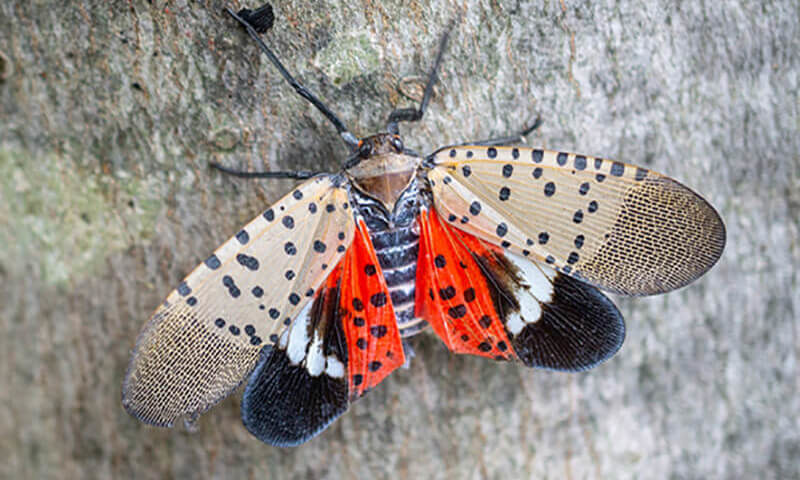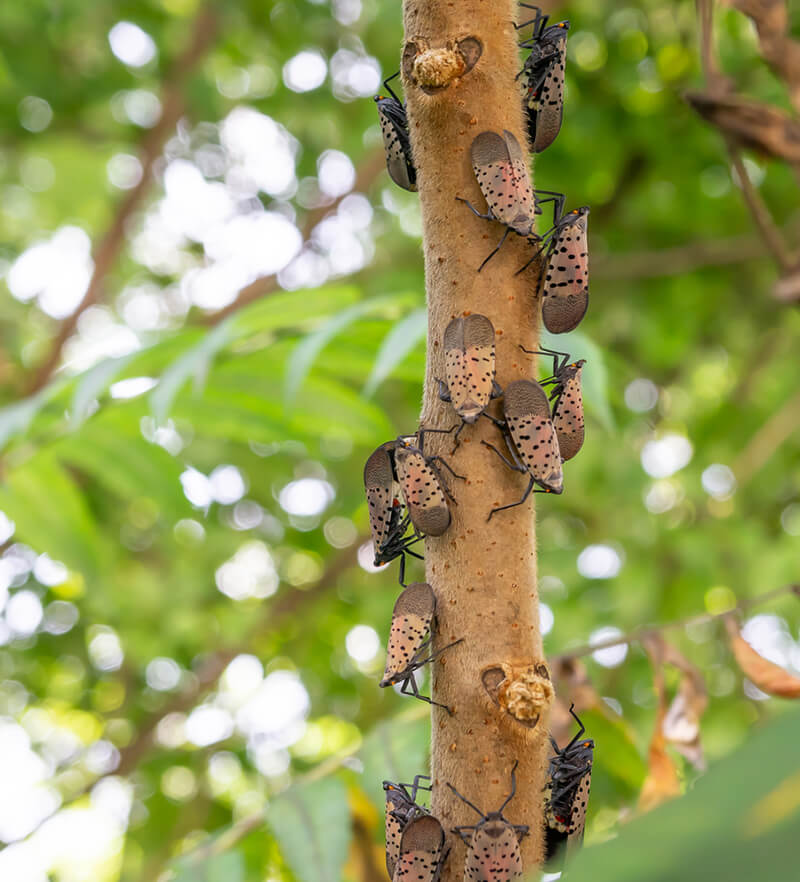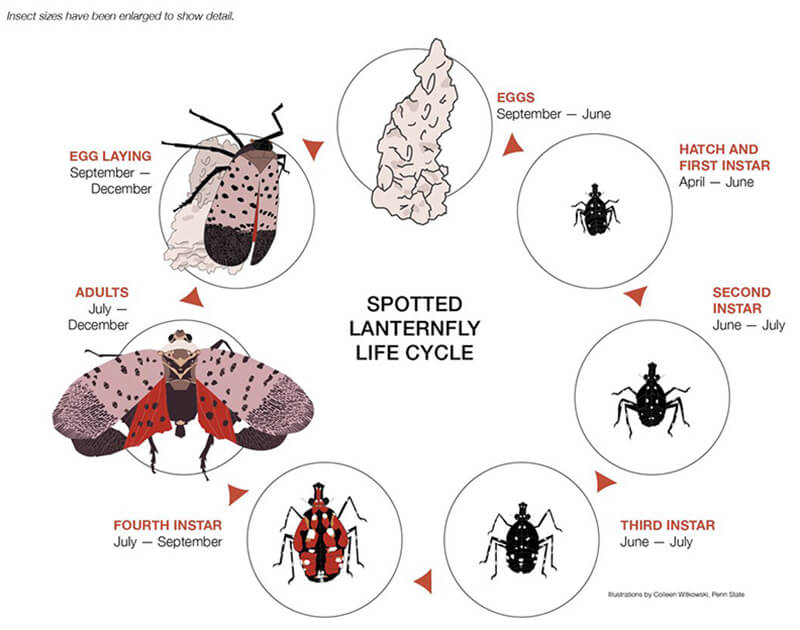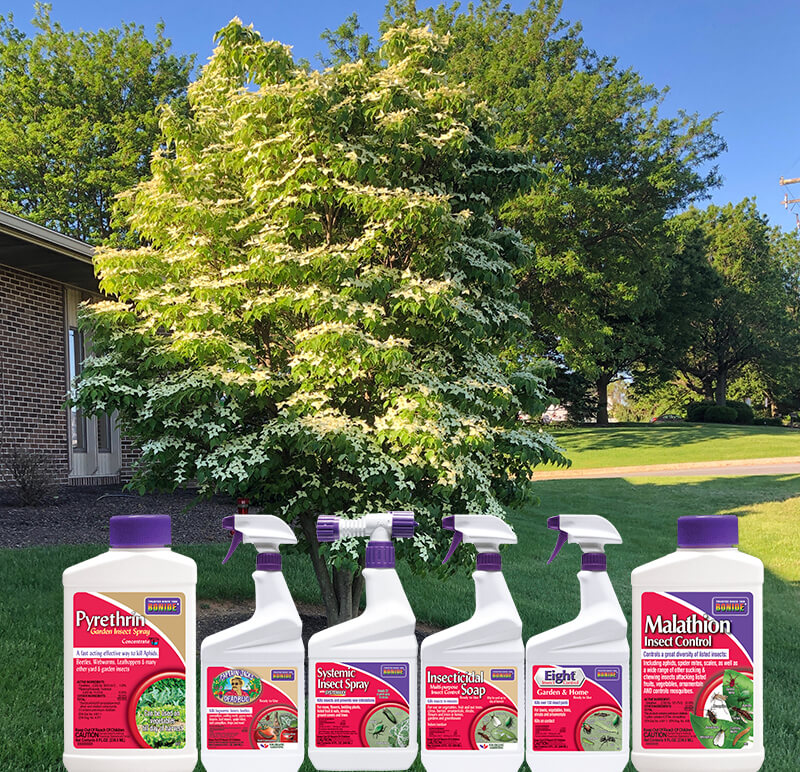Spot the Spotted Lanternfly

Stay Vigilant, Gardeners!
Perhaps you’ve seen this invasive insect online once or twice, but never before in person. Now, you might just notice this pest in your own backyard! The Spotted Lanternfly (SLF), or Lycorma delicatula, originates from China, India, Bangladesh, and Vietnam. As early as 2014, experts began spotting it in southeastern Pennsylvania, starting with Berks County. Since then, the species has spread to 14 counties in total across the commonwealth, inflicting damage as it goes. Pennsylvania considers these counties to be quarantined due to the potential high impact the Spotted Lanternfly has on their agricultural industries.
Counties Affected: Berks, Bucks, Carbon, Chester, Dauphin, Delaware, Lancaster, Lebanon, Lehigh, Monroe, Montgomery, Northampton, Philadelphia, and Schuylkill
What makes the spread of this species so harmful? The Spotted Lanternfly directly damages a variety of plant life, including:
- Apples, Grapes, Stone Fruits
- Hardwoods, Pines, Willows
- Hops
These industries contribute $18 billion annually towards Pennsylvania’s economy. Jobs and production within these industries face a serious threat, especially as the insect’s population continues to climb. Plus, these plant hoppers cause irreparable damage to expensive ornamental plants on private properties across the counties listed. People living within the affected communities report that the Spotted Lanternfly infestation has caused their quality of life to fall. They consider it more difficult to truly enjoy the outdoors, landscape, and even entertain guests. We don’t blame them!
So, the first question to ask is, “How does the Spotted Lanternfly damage these plants?”

Behavior
This pesky pest will not harm humans, never biting or stinging. However, it inflicts damage to plant life everywhere that it visits. With trees in particular, symptoms of oozing sap, wilting, leaf curling, and tree dieback can occur. When a Spotted Lanternfly chooses a spot to feed, it injects its piercing mouth part through the plant’s exterior like a straw. While collecting sap, the insect excretes a sugary substance known as “honeydew,” which facilitates the growth of black, sooty mold.
Luckily, this mold also does not endanger humans. On the other hand, your plants will not be so lucky. The presence of mold combined with the loss of sap slowly kills the targeted plant life. Trees like willows, maples, poplars, sycamores and flowering fruit trees like plum, cherry, and peach become feeding grounds, and without human intervention will succumb to the side effects caused by the Spotted Lanternfly. We should also mention that the sugary residue which they release may attract other pests like ants, bees, hornets, and wasps, just to name a few. If you have something planted close to your property that’s infested with these creatures, that’s just one more hamper on your quality of life.
Keep in mind, the Spotted Lanternfly goes through very distinct life cycles. One thing you should especially stay vigilant about is preventing them from reproducing, so let’s dive in to these life cycles and how to identify this destructive bug!
Identifying
Below shows a chart detailing the life cycle of the Spotted Lanternfly. As you can see, after the pests hatch they experience four instar phases before graduating to full fledged adults. In their immature stages they boast mostly black bodies with white spots, developing red patches as they mature. Adult Spotted Lanternflies have roughly 1 inch long and 1/2 inch wide bodies at rest. Their forewings are gray with black spots with tips having black blocks outlined in gray. The portion of their hindwings closer to the body is red with black spots, with the outer section showing black coloration with a white band. Their legs are black, and the abs are yellow with broad black bands. If you see a Spotted Lanternfly on your property, try your best to identify the exact life stage of the bug so that you can report your findings to officials.
Most of the insects emerge as adults in July and can be active all the way until Winter. During this time frame, they are extremely mobile, changing location often to fit their feeding needs. Thankfully, only adult Spotted Lanternflies can fly. While they have the ability to do so, they are actually better jumpers than fliers. They typically keep their wings closed throughout the day, only utilizing them when necessary. They are known to swarm however, coating decks and outdoor equipment with their honeydew as they land. Be mindful that as we transition into late Fall, we’re no longer solely on the hunt for the Spotted Lanternfly, but also their egg masses.

Egg Laying
Per general rule of thumb: if it’s an insect, it lays eggs! Spotted Lanternflies begin laying their egg masses in late Fall through early Spring. They actively seek out hard, smooth, vertical surfaces to host their masses such as trees, decks, patios, outdoor equipment, and rocks. Tree bark, stone, and brick prove to be among the most prevalent places that you’ll find them.
The egg masses are protected by a mud covering which help us identify them. Most masses contain upwards of around 30-50 eggs per mass. That’s a lot of Spotted Lanternflies! When it comes time for them to actually begin laying, they start to seek out their native host tree known as the Tree of Heaven (Ailanthus altissima), found essentially across the entire USA. The Tree of Heaven was introduced to the United States purposefully from Asia as a nice shade tree, though now that the Spotted Lanternfly made its way here, scientists regret that decision. Thus, one recommendation we have for stopping the spread of the Spotted Lanternfly is to remove this host tree if found anywhere on your property.
But, what else can be done?
Prevention and Elimination
First, let’s state the obvious. Kill it. Upon your first glimpse of the presence of any of the life stages on your property, take a picture for identification purposes. Then, you can squish and smash to your heart’s content. If that thought makes you a little unsettled, you can trap and seal them. They are very easy to catch and will scoop right into a container or baggie. Check your car and outdoor equipment often if you fall inside the quarantine zone, along with firewood, tools, patios, and grills. If you see their egg masses, you can scrape them off with ease and band your trees to help thwart their desire to visit them in the future.
We carry a number of products that aid in both the prevention and elimination of the Spotted Lanternfly. All-natural Captain Jack’s Dead Bug Brew is the most effective contact spray but Bonide Pyrethrin Garden Insect Spray, Bonide Insecticidal Soap, and EIGHT are also good choices. All these natural products can be applied directly to the insect. To prevent the Lanternfly from moving up and down the trunk of the tree, we carry Tanglefoot Insect Barrier that you can apply to Tanglefoot Banding Material. This wraps around the trunk of the tree.
For grapes and other edibles, Bonide Fruit Tree Spray is a combination spray for these types of plants. Just read and follow label directions on how many times a season that you can apply it.
If you prefer a systemic insecticide, you can apply Bonide ANNUAL Tree and Shrub Drench in late Fall or early Spring as a preventative. Keep in mind, this product may not be used on anything edible.

Tree of Heaven
We also have one last option that you can use for getting rid of that invasive Tree of Heaven. Try applying Stump & Vine Killer or Brush Killer Bk-32 Concentrate directly to the stump or cut bark of your Tree of Heaven to eradicate it.
Talk to our team members for assistance in choosing the product appropriate for your needs in your fight against the Spotted Lanternfly!
The Big Picture
While individual home owners and businesses have reason to take action against the Spotted Lanternfly on their own property, the commonwealth has also taken initiative. To help stop the spread, they ask residents in the quarantine zone to call 1-888-4BAD-FLY (1-888-422-3359) if they spot the insect. The hotline is available Monday through Friday from 8am to 7pm.
- You can also email pictures to badbug@pa.gov.
- You can even report spotted laternfly sightings here.
- Checkout the Department of Agriculture’s Spotted Lanternfly homepage.
The United States Department of Agriculture and the Pennsylvania Department of Agriculture began actively treating sites affected by the insect. Their goal in establishing the quarantine zone was to take preventative measures around its perimeter and force the bug inward for better containment. In 2018, the USDA even allocated $17.5 million towards addressing the spread of the Spotted Lanternfly. Commercial vehicles traveling in and out of the zone are required to obtain permits to do so. This requires those operating these vehicles to understand the regulations of the quarantine zone and verify that they currently are not carrying any of the insects on their vehicle.
Know How You Can Help
Business should take increased steps in raising awareness among their employees about the threat that the Spotted Lanternfly poses, as well as how to manage them. With this increased level of awareness combined with the efforts of the USDA and PDA, there is hope that the threat subsides in the near future.
Until then, here are some final checkpoints for you to follow:
- Know how to identify the life stages of the Spotted Lanternfly.
- Know how to identify and eliminate the Tree of Heaven.
- Routinely check your property, car, and outdoor equipment, especially before traveling outside the quarantine zone.
- Report any evidence of the insect to the appropriate government channels.
- Eliminate the insect using proper products and take action using preventatives.
- [Business] Train employees and obtain Spotted Lanternfly permits where necessary.
If you have any questions, please ask our in-store experts for the best product recommendations and advice on taking action. Together, let’s stop the spread of the Spotted Lanternfly and protect our agriculture!
